Earlier this month, a pair of Roseate Spoonbills caused quite a stir in the Triangle birding community by showing up at Lake Lynn in Raleigh. While these two were definitely a cool sight, they weren’t the only interesting bird to show up at Lake Lynn that day, check out this immature Little Blue Heron!

The young Heron was hanging out with the Spoonbills as they hunted for a meal together on the mud flats in the north end of Lake Lynn.
The larger birds seemed to tolerate the young one as the Little Blue followed the pair of Spoonbills like a puppy, following their every step through the shallow water.
Then, for whatever reason the Spoonbills decided to chase the Little Blue away.







The Heron tried to hide on a fallen willow branch but the Spoonbills pursued him relentlessly causing the Little Blue Heron to eventually make his escape by flying up into the higher boughs of a cypress tree.
Not long afterwards, Great Blue Heron flew in and watched the Little Blue intently.
Perhaps the larger Heron was eying the little one as potential meal lol!
After an hour or so of sitting in the tree top, the Little Blue Heron ended the interspecies standoff by launching himself from the tree into the air flying south across the water, disappearing around the bend of the shoreline.
Not long afterwards, the Spoobills headed out in the same direction…
Although they aren’t a particularly common sight at any location in North Carolina, coastal populations of Little Blue Herons are a year round resident of the Tarheel state and they’re also found here in the Triangle from June to August.
They are usually spotted hunting for fish, invertebrates, frogs, small reptiles and insects in shallow freshwater marshes, ponds and on mudflats.
Though it might seem that this elegant white bird is miss named, Little Blue Herons are indeed covered all over with a steel-purplish-blue colored plumage once they reach adulthood.
What a beauty!
Photos by @sally_siko of @birdwatching_nc on the full frame beast of an SLR, the mighty @canonusa
#5Ds


































